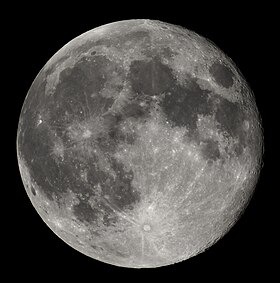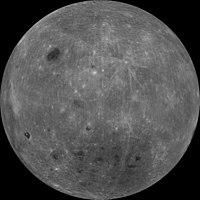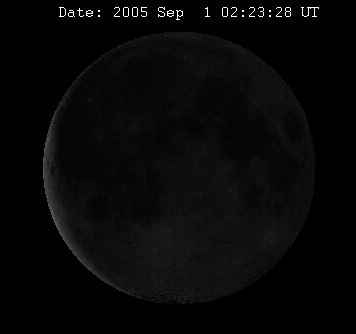Internal structure
Main article: Internal structure of the Moon

Schematic illustration of the internal structure of the Moon
The Moon is a differentiated body, being composed of a geochemically distinct crust, mantle, and core. This structure is hypothesized to have resulted from the fractional crystallization of a magma ocean shortly after its formation, at about 4.4 billion years ago[34]. The energy required to melt the outer portion of the Moon is commonly attributed to a giant impact event that is postulated to have formed the Earth-Moon system, and the subsequent reaccretion of material in Earth orbit. Crystallization of this magma ocean would have given rise to a mafic mantle and a plagioclase-rich crust (see Origin and geologic evolution below).
Geochemical mapping from orbit implies that the crust of the Moon is largely anorthositic in composition,[35] consistent with the magma ocean hypothesis. In terms of elements, the crust is composed primarily of oxygen (41% to 46% by mass), silicon (21%), magnesium (6%), iron (13%), calcium (8%), and aluminium (7%).[36][37] Based on geophysical techniques, its thickness is estimated to be on average about 50 km.[1]
Partial melting within the mantle of the Moon gave rise to the eruption of mare basalts on the lunar surface. Analyses of these basalts indicate that the mantle is composed predominantly of the minerals olivine, orthopyroxene and clinopyroxene, and that the lunar mantle is more iron rich than that of the Earth. Some lunar basalts contain high abundances of titanium (present in the mineral ilmenite), suggesting that the mantle is highly heterogeneous in composition. Moonquakes have been found to occur deep within the mantle of the Moon about a thousand kilometres below the surface. These occur with monthly periodicities and are related to tidal stresses caused by the eccentric orbit of the Moon about the Earth.[1]
The Moon has a mean density of 3 346.4 kg/m³, making it the second densest moon in the Solar System after Io. Nevertheless, several lines of evidence imply that the core of the Moon is small, with a radius of about 350 km or less.[1] This corresponds to only about 20% the size of the Moon, in contrast to about 50% as is the case for most other terrestrial bodies. The composition of the lunar core is not well constrained, but most believe that it is composed of metallic iron alloyed with a small amount of sulfur and nickel. Analyses of the Moon's time-variable rotation indicate that the core is at least partly molten.[38]
Topography
Main article: Topography of the Moon

Topography of the Moon, referenced to the lunar geoid
The topography of the Moon has been measured by the methods of laser altimetry and stereo image analysis, most recently from data obtained during the Clementine mission. The most visible topographic feature is the giant far side South Pole-Aitken basin, which possesses the lowest elevations of the Moon. The highest elevations are found just to the north-east of this basin, and it has been suggested that this area might represent thick ejecta deposits that were emplaced during an oblique South Pole-Aitken basin impact event. Other large impact basins, such as Imbrium, Serenitatis, Crisium, Smythii, and Orientale, also possess regionally low elevations and elevated rims. Another distinguishing feature of the Moon's shape is that the elevations are on average about 1.9 km higher on the far side than the near side.[1]
Gravity field
Main article: Gravity of the Moon
The gravitational field of the Moon has been determined through tracking of radio signals emitted by orbiting spacecraft. The principle used depends on the Doppler effect, whereby the spacecraft acceleration in the line-of-sight direction can be determined by means of small shifts in frequency of the radio signal, and the distance from the spacecraft to a station on Earth. However, because of the Moon's synchronous rotation it is not possible to track spacecraft much over the limbs of the Moon, and the farside gravity field is thus only poorly characterised.[39]

Radial gravitational anomaly at the surface of the Moon
The major characteristic of the Moon's gravitational field is the presence of mascons, which are large positive gravitational anomalies associated with some of the giant impact basins.[40] These anomalies greatly influence the orbit of spacecraft about the Moon, and an accurate gravitational model is necessary in the planning of both manned and unmanned missions. The mascons are in part due to the presence of dense mare basaltic lava flows that fill some of the impact basins. However, lava flows by themselves can not explain the entirety of the gravitational signature, and uplift of the crust-mantle interface is required as well. Based on Lunar Prospector gravitational models, it has been suggested that some mascons exist that do not show evidence for mare basaltic volcanism.[41] The huge expanse of mare basaltic volcanism associated with Oceanus Procellarum does not possess a positive gravitational anomaly.
Magnetic field
Main article: Magnetic field of the Moon

Total magnetic field strength at the surface of the Moon as derived from the Lunar Prospector electron reflectometer experiment
The Moon has an external magnetic field of the order of one to a hundred nanotesla—less than one hundredth that of the Earth, which is 30–60 microtesla. Other major differences are that the Moon does not currently have a dipolar magnetic field (as would be generated by a geodynamo in its core), and the magnetizations that are present are almost entirely crustal in origin.[42] One hypothesis holds that the crustal magnetizations were acquired early in lunar history when a geodynamo was still operating. The small size of the lunar core, however, is a potential obstacle to this theory. Alternatively, it is possible that on an airless body such as the Moon, transient magnetic fields could be generated during large impact events. In support of this, it has been noted that the largest crustal magnetizations appear to be located near the antipodes of the giant impact basins. It has been proposed that such a phenomenon could result from the free expansion of an impact generated plasma cloud around the Moon in the presence of an ambient magnetic field.[43]
Atmosphere
Main article: Atmosphere of the Moon
The Moon has an atmosphere so thin as to be almost negligible, with a total atmospheric mass of less than 104 kg.[44] The effective surface pressure of this small mass is around 3 × 10-15 atm.[45] This pressure varies, of course, with the diurnal moon cycle. One source of its atmosphere is outgassing—the release of gases such as radon that originate by radioactive decay processes within the crust and mantle.[46] Another important source is generated through the process of sputtering, which involves the bombardment of micrometeorites, solar wind ions, electrons, and sunlight.[35] Gases that are released by sputtering can either reimplant into the regolith as a result of the Moon's gravity, or can be lost to space either by solar radiation pressure or by being swept away by the solar wind magnetic field if they are ionised. The elements sodium (Na) and potassium (K) have been detected using earth-based spectroscopic methods, whereas the element radon–222 (222Rn) and polonium-210 (210Po) have been inferred from data obtained from the Lunar Prospector alpha particle spectrometer.[47] Argon–40 (40Ar), helium-4 (4He), oxygen (O2) and/or methane (CH4), nitrogen (N2) and/or carbon monoxide (CO), and carbon dioxide (CO2) were detected by in-situ detectors placed by the Apollo astronauts.[48]
Surface temperature
During the lunar day, the surface temperature averages 107 °C, and during the lunar night, it averages −153 °C.[49]
The Moon has the coldest place in the Solar System measured by a spacecraft.
NASA's Lunar Reconnaissance Orbiter has used its Diviner instrument to probe the insides of permanently shadowed craters on Earth's satellite. It found mid-winter, night-time surface temperatures inside the coldest craters in the northern polar region can dip as low as minus 249C (26 Kelvin). The Diviner instrument observed the lowest summer temperatures in the darkest craters at the southern pole to be about 35K (-238C); but in the north, close to the winter solstice the instrument recorded a temperature of just 26K on the south-western edge of the floor of Hermite Crater.
Calculations suggest one would have to travel to a distance beyond the Kuiper Belt - well beyond the orbit of Neptune - to find objects with surfaces this cold. The discovery adds further weight to the idea that some craters on the Moon could harbour water-ices for extended periods, and also more volatile substances that require even colder storage temperatures.















